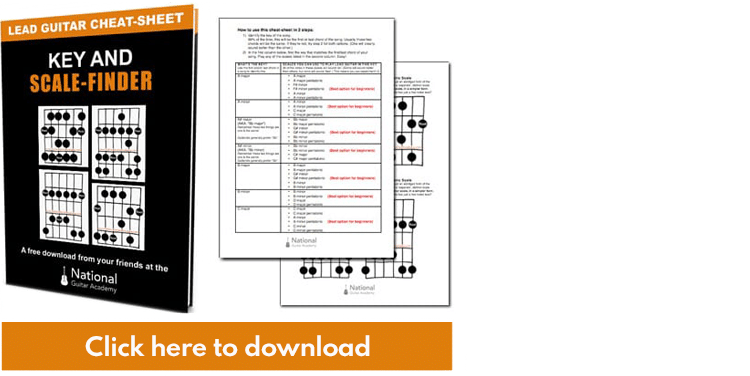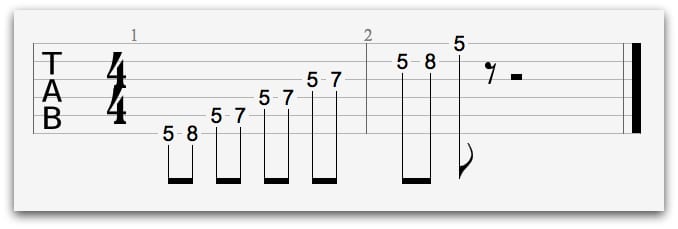Looking for guitar scales tabs? You’re in the right place!
In this free ultimate guide you will learn:
- 2 quick and easy tips that will make you learn scales at lightening speed.
- 4 essential guitar scales tabs that will make you sound incredible!
- The top secret tip that will help you learn scales in ALL keys.
Over 250,000 guitar-learners get our world-class guitar tips & tutorials sent straight to their inbox: Click here to join them
4 of the most popular scales used by all guitarists are:
- The Major Scale.
- The Minor Scale.
- The Minor Penatonic.
- The Blues Scale
For the purpose of these examples, we’re going to show you these scales in the key of A.
Let’s get cracking!
Guitar Scales Tabs | The Major Scale
The major scale is one of the most versatile scales you can learn. It can be used in a variety of genres such as rock, pop, blues, country and even jazz.
It has a bright and positive sound.
Here’s the guitar scales tabs:

When can I use this scale?
This scale works exclusively over major keys.
For example, if you were playing in the key of A major. The A major scale would work perfectly in this key.
Want to know how to learn guitar scales? go here: Learn Guitar Scales In 8 Easy Steps
Guitar Scales Tabs | The Minor Scale
The minor scale is the perfect scale to learn if you want to play rock, metal or even blues! It is less vibrant than the major scale, but its dark sound is perfect for creating tension and suspense.
You can use this scale in a minor key or over a minor chord.
To learn more about improvising in guitar keys go here: How To Play Lead Guitar
Here’s the guitar scales tabs:
Download our lead guitar cheat-sheet to make things easier
It's hard to understand which scales work with which keys.
So we created a cheat-sheet! A key and scale-finder that you can use again and again.

Get your personalised guitar-learning plan 🎸
Get a custom guitar-learning plan here: Click here for GuitarMetrics™
World-Class Guitar Courses 🌎
Learn from the world's best guitar educators: Click here for our guitar courses
Guitar Scales Tabs | The Minor Pentatonic Scale
The minor pentatonic scale is one of the easiest scales you can learn. Many people think that the minor scale and the minor pentatonic scale are two different scales.
This isn’t the case. Think of the minor pentatonic scale as the smaller brother of the minor scale.
They use the EXACT same notes, the minor pentatonic scale simply uses less.
If you’re familiar with rock or blues music, you have definitely heard this scale.
You can use this scale:
- Over any song which is in a minor key.
- Over a 12 bar blues.
- Over a minor chord.
Here’s the guitar scales tabs:

If you want to learn this scale in further detail, check out these articles:
Without guitar scales, guitar solos wouldn’t exist. Check out 50 of the greatest guitar solos here by the NME: 50 Greatest Guitar Solos | NME
Guitar Scales Tabs | The Blues Scale
This scale is popular amongst blues and rock guitarists as it has a great bluesy sound.
You can really spice up your guitar solos with this scale!
One of the best things about this scale is that it can be used over major and minor keys.
Here are a few examples of when you can use this classic scale:
- Over a major chord progression.
- Over a minor chord progression.
- Over a 12 bar blues.
To get the best out of the blues scale, experiment with using it in a variety of different musical situations.
Here’s the guitar scales tabs for this cool scale:

Try using this scale over this A blues backing track:
If you want to know more about blues guitar, go here:Blues Guitar Lessons For Beginners : 4 Ways To Sound Awesome Quickly
Do I need to learn guitar scales in different keys?
The short answer is, yes you do.
The 5 most common guitar keys are C, A, G, E and D.
We’re going to show you each of the guitar scales tabs for each of these keys.
The C Major Scale
Here’s the major scale tabbed out in the key of C:

You can use this scale over anything in the key of C major.
Want to know more about the key of C major? Go here: Understanding the chords in the key of C
We’ve already learnt the major scale in the key of A. So the next major scale key we must learn is the key of G.
The G Major Scale
Here’s the guitar scales tabs for the G major scale:

You can use this chord over anything in the key of G major.
Learn more about the key of G major here: Chords in the key of G and tips for understanding keys
The E Major Scale
Here’s the guitar scales tabs for the major scale in the key of E:

Learn this scale if you want to solo in the key of E major.
Learn more about the key of E major here: Chords In The Key Of E
The D Major Scale
The final major scale key you must know is the key of D major.
Here’s the guitar scales tabs:
Now we’ve learned the major scale in 5 of the most common keys. Let’s learn the minor scale equivalents.
When you learn the minor scale, the keys have to change.
Instead of the keys being C, A, G, E and D.
They are now:
- A minor.
- F#minor.
- E minor.
- C# minor.
- B minor.
These are known as relative keys.
Let’s learn each of the minor scales in these keys.
Join over 250,000 guitar learners and subscribe to our guitar-tips-by-email service. (It's free.) We'll send you a series of lessons that will move you to the next level of your guitar journey. Learn how everything fits together quickly, easily and effectively. We share ninja tips (for instant fun!) but also timeless fundamentals that will deepen your understanding. To become a better guitarist click here to see our guitar courses Want us to make a guitar-learning plan that is customised to you? Click here for GuitarMetrics™Want free guitar tips and video lessons delivered to your inbox?

Our Guitar Courses
Get your personalised guitar-learning plan 🎸
The F# Minor Scale
We’ve already learned the minor scale, minor pentatonic and the blues scale in the key of A minor.
So, let’s start with the key of F# minor.
Here’s the guitar scales tabs:

The F# Minor Pentatonic Scale
Here’s the guitar scales tabs for the F# minor pentatonic:

The F# Blues Scale
Here’s the tab for the F# blues scale:

All of these scales would work over the following chord progressions.
- Anything in the key of F# minor.
- A F# blues.
F# minor is the relative minor key of A major.
Therefore you could use any of these scales over the key of A major.
Now we’ve learned all of our scales in the key of F# minor, let’s move on to the next key, E minor.
The E Minor Scale
Here’s the guitar scales tabs for the E minor scale:

The E Minor Pentatonic Scale
Here’s the tab for the E minor pentatonic scale:

To learn how to use this scale in a musical context go here:E Minor Pentatonic Scale: The Ultimate Guide
Get our best guitar tips & videos
Where should we send it?
Get our best guitar tips & videos




